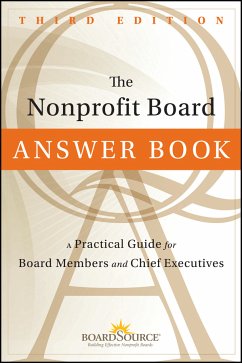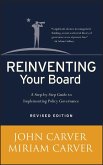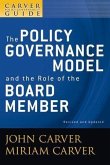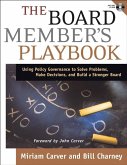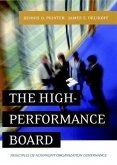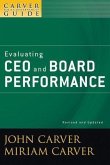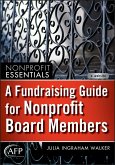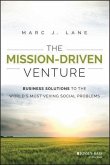Boardsource
The Nonprofit Board Answer Book (eBook, PDF)
A Practical Guide for Board Members and Chief Executives
34,99 €
34,99 €
inkl. MwSt.
Sofort per Download lieferbar

0 °P sammeln
34,99 €
Als Download kaufen

34,99 €
inkl. MwSt.
Sofort per Download lieferbar

0 °P sammeln
Jetzt verschenken
Alle Infos zum eBook verschenken
34,99 €
inkl. MwSt.
Sofort per Download lieferbar
Alle Infos zum eBook verschenken

0 °P sammeln
Boardsource
The Nonprofit Board Answer Book (eBook, PDF)
A Practical Guide for Board Members and Chief Executives
- Format: PDF
- Merkliste
- Auf die Merkliste
- Bewerten Bewerten
- Teilen
- Produkt teilen
- Produkterinnerung
- Produkterinnerung

Bitte loggen Sie sich zunächst in Ihr Kundenkonto ein oder registrieren Sie sich bei
bücher.de, um das eBook-Abo tolino select nutzen zu können.
Hier können Sie sich einloggen
Hier können Sie sich einloggen
Sie sind bereits eingeloggt. Klicken Sie auf 2. tolino select Abo, um fortzufahren.

Bitte loggen Sie sich zunächst in Ihr Kundenkonto ein oder registrieren Sie sich bei bücher.de, um das eBook-Abo tolino select nutzen zu können.
An essential guide to good governance for board leaders at all levels of experience and expertise
This third edition of the bestselling book for nonprofit board members and professionals offers a thoroughly revised and updated resource that answers the most-commonly asked question on board governance. The book covers such topics as board structure and process, board member recruitment and orientation, board-staff relations, and financial management. This new edition includes updated information on topics that have recently increased in importance including new Form 990; dealing with the…mehr
- Geräte: PC
- ohne Kopierschutz
- eBook Hilfe
Andere Kunden interessierten sich auch für
![Reinventing Your Board (eBook, PDF) Reinventing Your Board (eBook, PDF)]() John CarverReinventing Your Board (eBook, PDF)40,99 €
John CarverReinventing Your Board (eBook, PDF)40,99 €![A Carver Policy Governance Guide, Volume 1, Revised and Updated, The Policy Governance Model and the Role of the Board Member (eBook, PDF) A Carver Policy Governance Guide, Volume 1, Revised and Updated, The Policy Governance Model and the Role of the Board Member (eBook, PDF)]() John CarverA Carver Policy Governance Guide, Volume 1, Revised and Updated, The Policy Governance Model and the Role of the Board Member (eBook, PDF)21,99 €
John CarverA Carver Policy Governance Guide, Volume 1, Revised and Updated, The Policy Governance Model and the Role of the Board Member (eBook, PDF)21,99 €![The Board Member's Playbook (eBook, PDF) The Board Member's Playbook (eBook, PDF)]() Miriam CarverThe Board Member's Playbook (eBook, PDF)46,99 €
Miriam CarverThe Board Member's Playbook (eBook, PDF)46,99 €![The High-Performance Board (eBook, PDF) The High-Performance Board (eBook, PDF)]() Dennis D. PointerThe High-Performance Board (eBook, PDF)39,99 €
Dennis D. PointerThe High-Performance Board (eBook, PDF)39,99 €![A Carver Policy Governance Guide, Volume 5, Revised and Updated, Evaluating CEO and Board Performance (eBook, PDF) A Carver Policy Governance Guide, Volume 5, Revised and Updated, Evaluating CEO and Board Performance (eBook, PDF)]() John CarverA Carver Policy Governance Guide, Volume 5, Revised and Updated, Evaluating CEO and Board Performance (eBook, PDF)18,99 €
John CarverA Carver Policy Governance Guide, Volume 5, Revised and Updated, Evaluating CEO and Board Performance (eBook, PDF)18,99 €![A Fundraising Guide for Nonprofit Board Members (eBook, PDF) A Fundraising Guide for Nonprofit Board Members (eBook, PDF)]() Julia I. WalkerA Fundraising Guide for Nonprofit Board Members (eBook, PDF)34,99 €
Julia I. WalkerA Fundraising Guide for Nonprofit Board Members (eBook, PDF)34,99 €![The Mission-Driven Venture (eBook, PDF) The Mission-Driven Venture (eBook, PDF)]() Marc J. LaneThe Mission-Driven Venture (eBook, PDF)21,99 €
Marc J. LaneThe Mission-Driven Venture (eBook, PDF)21,99 €-
-
-
An essential guide to good governance for board leaders at all levels of experience and expertise
This third edition of the bestselling book for nonprofit board members and professionals offers a thoroughly revised and updated resource that answers the most-commonly asked question on board governance. The book covers such topics as board structure and process, board member recruitment and orientation, board-staff relations, and financial management. This new edition includes updated information on topics that have recently increased in importance including new Form 990; dealing with the financial crisis, risk management, and mergers.
Offers insight gained from the BoardSource Governance Index Survey, hundreds of board self-assessments, and questions and challenges heard by BoardSource from thousands of nonprofit leaders.
Hinweis: Dieser Artikel kann nur an eine deutsche Lieferadresse ausgeliefert werden.
This third edition of the bestselling book for nonprofit board members and professionals offers a thoroughly revised and updated resource that answers the most-commonly asked question on board governance. The book covers such topics as board structure and process, board member recruitment and orientation, board-staff relations, and financial management. This new edition includes updated information on topics that have recently increased in importance including new Form 990; dealing with the financial crisis, risk management, and mergers.
- Shows executives and board members how to be more effective, meet difficult situations head-on, and deal with commonplace challenges with confidence
- Topics include information on the viability of for-profit ventures, board retreats, board diversity, fundraising, financial oversight, strategic thinking, and the use of technology
- From Boardsource the premier resource for practical information, tools, best practices, training, and leadership development for board members of nonprofit organizations worldwide
Offers insight gained from the BoardSource Governance Index Survey, hundreds of board self-assessments, and questions and challenges heard by BoardSource from thousands of nonprofit leaders.
Dieser Download kann aus rechtlichen Gründen nur mit Rechnungsadresse in D ausgeliefert werden.
Hinweis: Dieser Artikel kann nur an eine deutsche Lieferadresse ausgeliefert werden.
Produktdetails
- Produktdetails
- Verlag: John Wiley & Sons
- Erscheinungstermin: 8. November 2011
- Englisch
- ISBN-13: 9781118127049
- Artikelnr.: 38235480
- Verlag: John Wiley & Sons
- Erscheinungstermin: 8. November 2011
- Englisch
- ISBN-13: 9781118127049
- Artikelnr.: 38235480
- Herstellerkennzeichnung Die Herstellerinformationen sind derzeit nicht verfügbar.
BoardSource is the premier resource for practical information, tools, best practices, training, and leadership development for board mem- bers of nonprofit organizations worldwide. Through its highly acclaimed programs and services, BoardSource enables organizations to fulfill their missions by helping build strong and effective nonprofit boards.
About BoardSource v
Introduction: The World of Nonprofits xv
Part One: Basic Board Functions
1 What are the basic responsibilities of a nonprofi t board? 3
2 What are the legal duties of a board member? 6
3 What is the board's role and involvement in mission, vision, and values?
9
4 What is the board's role in fi nancial management? 12
5 What is the board's role in strategic planning? 16
6 How does strategic thinking contribute to board and organizational
effectiveness? 20
7 What is the board's role in fundraising? 23
8 What is the board's role in organizational evaluation? 27
9 How does the board avoid the extremes of "rubber stamping" and
micromanaging? 32
10 Why is connecting and communicating with constituencies an important
task for the board? 36
11 How does a board function as a team? 40
12 What are the attributes of a high-performing board? 43
Part Two: Board Structure
13 What is the best size for our board? 49
14 How should we structure our board? 52
15 What types of board committees should we have? 55
16 How can our committees be most effective? 58
17 Does our board need an executive committee? 62
18 Should our board have advisory councils? 65
19 What is the role of the board chair? 69
20 What board offi cers should we have? 73
21 How should we select our board offi cers? 76
22 What kind of board does an all-volunteer organization have? 79
Part Three: Board Member Selection and Development
23 How can we recruit active, involved board members? 85
24 How can we use a board matrix to identify recruitment needs? 89
25 What is the chief executive's role in board recruitment? 93
26 How can a membership organization build an effective board? 95
27 How can our board become more diverse and inclusive? 98
28 What should we tell our prospective board members? 101
29 What should we include in our board orientation? 106
30 Should members of the same family serve on a board? 109
31 Should constituents serve on the board? 112
32 What should we do about uninvolved board members? 114
33 Should we have term limits for board members? 119
34 How can we engage former board members and chief executives? 122
35 Should board members be compensated? 126
36 How can our board assess and improve its own performance? 130
37 Should individual board members be evaluated, and, if so, how? 136
Part Four: Board and Committee Meetings
38 Is a board legally required to hold open meetings? 141
39 How often and where should we meet? 144
40 How can we improve our meetings? 147
41 How can we encourage debate while promoting civility in the boardroom?
154
42 What is the purpose of a board retreat? 158
43 Who should attend board meetings, and what are their roles? 160
44 How should staff members participate in board and committee meetings?
163
45 What are the different ways boards make decisions? 167
46 How should board minutes be written, approved, and kept? 170
47 How can e-governance improve board and committee work? 174
Part Five: The Board's Role as a Fiduciary
48 How does a board help ensure the organization's long-term viability? 181
49 What does the board need to know about reserves and investments? 185
50 What is the board's role in the budget? 190
51 What is the board's role in the annual financial audit? 193
52 What are the signs of fi nancial distress in an organization? 197
53 What should we do if we suspect fraudulent activity? 200
54 What policies and practices should we adopt to manage confl ict of
interest? 205
55 How can we protect the organization-and ourselves-from lawsuits? 210
56 What is a Form 990? 216
57 Why should every board member make an annual monetary contribution? 219
58 How can we develop board members' fundraising skills? 222
59 How can we generate revenue beyond fundraising? 225
60 How does a nonprofi t operate a for-profit subsidiary? 230
61 What's the best way to keep track of board policies? 236
Part Six: Board-Staff Relations
62 How does an all-volunteer organization make the transition to paid
staff? 243
63 What is the board's involvement in staff selection and management? 247
64 What is the ideal relationship between the board chair and the chief
executive? 251
65 Should the chief executive have a vote on the board? 257
66 Should board members be hired as staff members? 259
67 How should we evaluate the chief executive? 261
68 How do we set fair compensation for the chief executive and the staff?
265
69 What is the chief executive's role in improving the board? 269
70 What is the board's role in relation to the staff? 273
71 How can the senior staff contribute to board effectiveness? 276
72 How can we facilitate the end of a chief executive's employment? 280
73 What characteristics should we look for in a new chief executive? 286
74 How do we fi nd a new chief executive? 291
Part Seven: Organizational Change
75 What is the typical lifecycle for a nonprofi t organization? 299
76 How do we ensure that the organization thrives after the founders
depart? 304
77 When should an organization consider revising its mission statement? 307
78 When should we enter into strategic alliances with other organizations?
310
79 When should we consider a merger or acquisition? 313
80 How can we expand the organization's scope to an international level?
318
81 Should our charitable organization engage in lobbying? 323
82 How should we respond to an organizational emergency or controversy? 326
83 What is the board's role in hiring a consultant? 330
84 When should the board consider closing a nonprofit organization? 332
85 How does the board keep up with organizational change? 335
Conclusion 339
Index 343
Introduction: The World of Nonprofits xv
Part One: Basic Board Functions
1 What are the basic responsibilities of a nonprofi t board? 3
2 What are the legal duties of a board member? 6
3 What is the board's role and involvement in mission, vision, and values?
9
4 What is the board's role in fi nancial management? 12
5 What is the board's role in strategic planning? 16
6 How does strategic thinking contribute to board and organizational
effectiveness? 20
7 What is the board's role in fundraising? 23
8 What is the board's role in organizational evaluation? 27
9 How does the board avoid the extremes of "rubber stamping" and
micromanaging? 32
10 Why is connecting and communicating with constituencies an important
task for the board? 36
11 How does a board function as a team? 40
12 What are the attributes of a high-performing board? 43
Part Two: Board Structure
13 What is the best size for our board? 49
14 How should we structure our board? 52
15 What types of board committees should we have? 55
16 How can our committees be most effective? 58
17 Does our board need an executive committee? 62
18 Should our board have advisory councils? 65
19 What is the role of the board chair? 69
20 What board offi cers should we have? 73
21 How should we select our board offi cers? 76
22 What kind of board does an all-volunteer organization have? 79
Part Three: Board Member Selection and Development
23 How can we recruit active, involved board members? 85
24 How can we use a board matrix to identify recruitment needs? 89
25 What is the chief executive's role in board recruitment? 93
26 How can a membership organization build an effective board? 95
27 How can our board become more diverse and inclusive? 98
28 What should we tell our prospective board members? 101
29 What should we include in our board orientation? 106
30 Should members of the same family serve on a board? 109
31 Should constituents serve on the board? 112
32 What should we do about uninvolved board members? 114
33 Should we have term limits for board members? 119
34 How can we engage former board members and chief executives? 122
35 Should board members be compensated? 126
36 How can our board assess and improve its own performance? 130
37 Should individual board members be evaluated, and, if so, how? 136
Part Four: Board and Committee Meetings
38 Is a board legally required to hold open meetings? 141
39 How often and where should we meet? 144
40 How can we improve our meetings? 147
41 How can we encourage debate while promoting civility in the boardroom?
154
42 What is the purpose of a board retreat? 158
43 Who should attend board meetings, and what are their roles? 160
44 How should staff members participate in board and committee meetings?
163
45 What are the different ways boards make decisions? 167
46 How should board minutes be written, approved, and kept? 170
47 How can e-governance improve board and committee work? 174
Part Five: The Board's Role as a Fiduciary
48 How does a board help ensure the organization's long-term viability? 181
49 What does the board need to know about reserves and investments? 185
50 What is the board's role in the budget? 190
51 What is the board's role in the annual financial audit? 193
52 What are the signs of fi nancial distress in an organization? 197
53 What should we do if we suspect fraudulent activity? 200
54 What policies and practices should we adopt to manage confl ict of
interest? 205
55 How can we protect the organization-and ourselves-from lawsuits? 210
56 What is a Form 990? 216
57 Why should every board member make an annual monetary contribution? 219
58 How can we develop board members' fundraising skills? 222
59 How can we generate revenue beyond fundraising? 225
60 How does a nonprofi t operate a for-profit subsidiary? 230
61 What's the best way to keep track of board policies? 236
Part Six: Board-Staff Relations
62 How does an all-volunteer organization make the transition to paid
staff? 243
63 What is the board's involvement in staff selection and management? 247
64 What is the ideal relationship between the board chair and the chief
executive? 251
65 Should the chief executive have a vote on the board? 257
66 Should board members be hired as staff members? 259
67 How should we evaluate the chief executive? 261
68 How do we set fair compensation for the chief executive and the staff?
265
69 What is the chief executive's role in improving the board? 269
70 What is the board's role in relation to the staff? 273
71 How can the senior staff contribute to board effectiveness? 276
72 How can we facilitate the end of a chief executive's employment? 280
73 What characteristics should we look for in a new chief executive? 286
74 How do we fi nd a new chief executive? 291
Part Seven: Organizational Change
75 What is the typical lifecycle for a nonprofi t organization? 299
76 How do we ensure that the organization thrives after the founders
depart? 304
77 When should an organization consider revising its mission statement? 307
78 When should we enter into strategic alliances with other organizations?
310
79 When should we consider a merger or acquisition? 313
80 How can we expand the organization's scope to an international level?
318
81 Should our charitable organization engage in lobbying? 323
82 How should we respond to an organizational emergency or controversy? 326
83 What is the board's role in hiring a consultant? 330
84 When should the board consider closing a nonprofit organization? 332
85 How does the board keep up with organizational change? 335
Conclusion 339
Index 343
About BoardSource v
Introduction: The World of Nonprofits xv
Part One: Basic Board Functions
1 What are the basic responsibilities of a nonprofi t board? 3
2 What are the legal duties of a board member? 6
3 What is the board's role and involvement in mission, vision, and values?
9
4 What is the board's role in fi nancial management? 12
5 What is the board's role in strategic planning? 16
6 How does strategic thinking contribute to board and organizational
effectiveness? 20
7 What is the board's role in fundraising? 23
8 What is the board's role in organizational evaluation? 27
9 How does the board avoid the extremes of "rubber stamping" and
micromanaging? 32
10 Why is connecting and communicating with constituencies an important
task for the board? 36
11 How does a board function as a team? 40
12 What are the attributes of a high-performing board? 43
Part Two: Board Structure
13 What is the best size for our board? 49
14 How should we structure our board? 52
15 What types of board committees should we have? 55
16 How can our committees be most effective? 58
17 Does our board need an executive committee? 62
18 Should our board have advisory councils? 65
19 What is the role of the board chair? 69
20 What board offi cers should we have? 73
21 How should we select our board offi cers? 76
22 What kind of board does an all-volunteer organization have? 79
Part Three: Board Member Selection and Development
23 How can we recruit active, involved board members? 85
24 How can we use a board matrix to identify recruitment needs? 89
25 What is the chief executive's role in board recruitment? 93
26 How can a membership organization build an effective board? 95
27 How can our board become more diverse and inclusive? 98
28 What should we tell our prospective board members? 101
29 What should we include in our board orientation? 106
30 Should members of the same family serve on a board? 109
31 Should constituents serve on the board? 112
32 What should we do about uninvolved board members? 114
33 Should we have term limits for board members? 119
34 How can we engage former board members and chief executives? 122
35 Should board members be compensated? 126
36 How can our board assess and improve its own performance? 130
37 Should individual board members be evaluated, and, if so, how? 136
Part Four: Board and Committee Meetings
38 Is a board legally required to hold open meetings? 141
39 How often and where should we meet? 144
40 How can we improve our meetings? 147
41 How can we encourage debate while promoting civility in the boardroom?
154
42 What is the purpose of a board retreat? 158
43 Who should attend board meetings, and what are their roles? 160
44 How should staff members participate in board and committee meetings?
163
45 What are the different ways boards make decisions? 167
46 How should board minutes be written, approved, and kept? 170
47 How can e-governance improve board and committee work? 174
Part Five: The Board's Role as a Fiduciary
48 How does a board help ensure the organization's long-term viability? 181
49 What does the board need to know about reserves and investments? 185
50 What is the board's role in the budget? 190
51 What is the board's role in the annual financial audit? 193
52 What are the signs of fi nancial distress in an organization? 197
53 What should we do if we suspect fraudulent activity? 200
54 What policies and practices should we adopt to manage confl ict of
interest? 205
55 How can we protect the organization-and ourselves-from lawsuits? 210
56 What is a Form 990? 216
57 Why should every board member make an annual monetary contribution? 219
58 How can we develop board members' fundraising skills? 222
59 How can we generate revenue beyond fundraising? 225
60 How does a nonprofi t operate a for-profit subsidiary? 230
61 What's the best way to keep track of board policies? 236
Part Six: Board-Staff Relations
62 How does an all-volunteer organization make the transition to paid
staff? 243
63 What is the board's involvement in staff selection and management? 247
64 What is the ideal relationship between the board chair and the chief
executive? 251
65 Should the chief executive have a vote on the board? 257
66 Should board members be hired as staff members? 259
67 How should we evaluate the chief executive? 261
68 How do we set fair compensation for the chief executive and the staff?
265
69 What is the chief executive's role in improving the board? 269
70 What is the board's role in relation to the staff? 273
71 How can the senior staff contribute to board effectiveness? 276
72 How can we facilitate the end of a chief executive's employment? 280
73 What characteristics should we look for in a new chief executive? 286
74 How do we fi nd a new chief executive? 291
Part Seven: Organizational Change
75 What is the typical lifecycle for a nonprofi t organization? 299
76 How do we ensure that the organization thrives after the founders
depart? 304
77 When should an organization consider revising its mission statement? 307
78 When should we enter into strategic alliances with other organizations?
310
79 When should we consider a merger or acquisition? 313
80 How can we expand the organization's scope to an international level?
318
81 Should our charitable organization engage in lobbying? 323
82 How should we respond to an organizational emergency or controversy? 326
83 What is the board's role in hiring a consultant? 330
84 When should the board consider closing a nonprofit organization? 332
85 How does the board keep up with organizational change? 335
Conclusion 339
Index 343
Introduction: The World of Nonprofits xv
Part One: Basic Board Functions
1 What are the basic responsibilities of a nonprofi t board? 3
2 What are the legal duties of a board member? 6
3 What is the board's role and involvement in mission, vision, and values?
9
4 What is the board's role in fi nancial management? 12
5 What is the board's role in strategic planning? 16
6 How does strategic thinking contribute to board and organizational
effectiveness? 20
7 What is the board's role in fundraising? 23
8 What is the board's role in organizational evaluation? 27
9 How does the board avoid the extremes of "rubber stamping" and
micromanaging? 32
10 Why is connecting and communicating with constituencies an important
task for the board? 36
11 How does a board function as a team? 40
12 What are the attributes of a high-performing board? 43
Part Two: Board Structure
13 What is the best size for our board? 49
14 How should we structure our board? 52
15 What types of board committees should we have? 55
16 How can our committees be most effective? 58
17 Does our board need an executive committee? 62
18 Should our board have advisory councils? 65
19 What is the role of the board chair? 69
20 What board offi cers should we have? 73
21 How should we select our board offi cers? 76
22 What kind of board does an all-volunteer organization have? 79
Part Three: Board Member Selection and Development
23 How can we recruit active, involved board members? 85
24 How can we use a board matrix to identify recruitment needs? 89
25 What is the chief executive's role in board recruitment? 93
26 How can a membership organization build an effective board? 95
27 How can our board become more diverse and inclusive? 98
28 What should we tell our prospective board members? 101
29 What should we include in our board orientation? 106
30 Should members of the same family serve on a board? 109
31 Should constituents serve on the board? 112
32 What should we do about uninvolved board members? 114
33 Should we have term limits for board members? 119
34 How can we engage former board members and chief executives? 122
35 Should board members be compensated? 126
36 How can our board assess and improve its own performance? 130
37 Should individual board members be evaluated, and, if so, how? 136
Part Four: Board and Committee Meetings
38 Is a board legally required to hold open meetings? 141
39 How often and where should we meet? 144
40 How can we improve our meetings? 147
41 How can we encourage debate while promoting civility in the boardroom?
154
42 What is the purpose of a board retreat? 158
43 Who should attend board meetings, and what are their roles? 160
44 How should staff members participate in board and committee meetings?
163
45 What are the different ways boards make decisions? 167
46 How should board minutes be written, approved, and kept? 170
47 How can e-governance improve board and committee work? 174
Part Five: The Board's Role as a Fiduciary
48 How does a board help ensure the organization's long-term viability? 181
49 What does the board need to know about reserves and investments? 185
50 What is the board's role in the budget? 190
51 What is the board's role in the annual financial audit? 193
52 What are the signs of fi nancial distress in an organization? 197
53 What should we do if we suspect fraudulent activity? 200
54 What policies and practices should we adopt to manage confl ict of
interest? 205
55 How can we protect the organization-and ourselves-from lawsuits? 210
56 What is a Form 990? 216
57 Why should every board member make an annual monetary contribution? 219
58 How can we develop board members' fundraising skills? 222
59 How can we generate revenue beyond fundraising? 225
60 How does a nonprofi t operate a for-profit subsidiary? 230
61 What's the best way to keep track of board policies? 236
Part Six: Board-Staff Relations
62 How does an all-volunteer organization make the transition to paid
staff? 243
63 What is the board's involvement in staff selection and management? 247
64 What is the ideal relationship between the board chair and the chief
executive? 251
65 Should the chief executive have a vote on the board? 257
66 Should board members be hired as staff members? 259
67 How should we evaluate the chief executive? 261
68 How do we set fair compensation for the chief executive and the staff?
265
69 What is the chief executive's role in improving the board? 269
70 What is the board's role in relation to the staff? 273
71 How can the senior staff contribute to board effectiveness? 276
72 How can we facilitate the end of a chief executive's employment? 280
73 What characteristics should we look for in a new chief executive? 286
74 How do we fi nd a new chief executive? 291
Part Seven: Organizational Change
75 What is the typical lifecycle for a nonprofi t organization? 299
76 How do we ensure that the organization thrives after the founders
depart? 304
77 When should an organization consider revising its mission statement? 307
78 When should we enter into strategic alliances with other organizations?
310
79 When should we consider a merger or acquisition? 313
80 How can we expand the organization's scope to an international level?
318
81 Should our charitable organization engage in lobbying? 323
82 How should we respond to an organizational emergency or controversy? 326
83 What is the board's role in hiring a consultant? 330
84 When should the board consider closing a nonprofit organization? 332
85 How does the board keep up with organizational change? 335
Conclusion 339
Index 343
